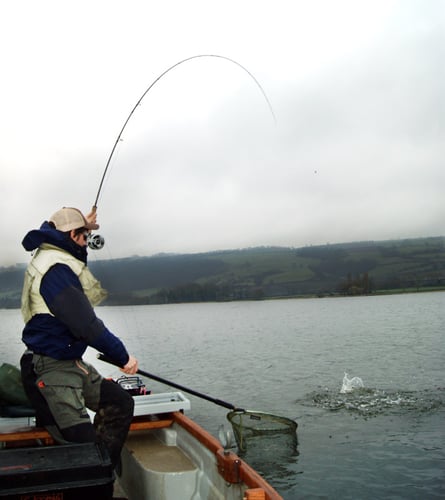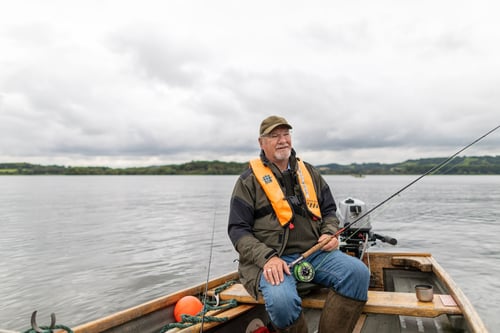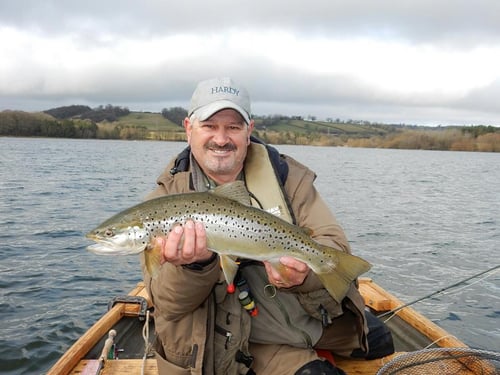Our fish farm
Bristol Water Fisheries has more than a 100-year history of rearing trout to stock our lakes.
About the fish farm
Each year our fish farm produces more than 90 tonnes of rainbow trout.
This is a major part of our day-to-day operations and we take great care to rear high-quality fish for our customers.
As many anglers are unaware of our fish-rearing programme, we would like to take this opportunity to give you a behind-the-scenes look at growing trout from ova to an average size of 1kg.



Early stages
Ubley hatchery is our original fish-farming facility. Fish have been reared here since the turn of the 20th century when Blagdon received approximately 80,000 yearling trout per year.
The subsequent addition of Chew and Barrow reservoirs as trout fisheries now demands that we acquire 200,000 ova per annum to ensure we can meet stocking targets each year.
Since 2013 all of our ova are purchased from certified egg suppliers that deliver triploid eggs at the eyed ova stage. Upon arrival, the eggs are taken from ice-packed polystyrene boxes and laid down into trays with up to 8,000 eggs per tray. Depending on water temperature the eyed ova should hatch after approximately five to seven days in the hatchery.
After hatching the new-born trout, known as alevins, wriggle down through the egg trays into the troughs and continue to absorb their yolk sac for nutrition. At this stage the alevins have an aversion to light, so covers are placed over the troughs in order to minimise stress. Once the yolk sac is fully absorbed the first feeding fry will begin to swim up in search of their first meal. At the first feeding stage tiny crumb-sized fish feed is fed regularly throughout the day to get the trout accustomed to their new diet of fish pellets.
As the trout grow larger they are progressively graded into larger holding units and given increasingly bigger pellets. We aim to rear trout to between 150g and 400g at the Ubley site before the fish outgrow these holding units and are moved to bigger pens at Blagdon Pumphouse or Chew Valley Lake. Most trout will spend the first 10 to 12 months of their life being reared at Ubley Hatchery.
Ongrowing
Blagdon Pumping Station is our main ongrowing site with units suitable for growing fish from 150g onwards.
We can hold up to 55,000 trout on site and once fish enter a holding unit, they are largely left undisturbed until they reach the desired weight for stocking. Although the pumphouse was never designed as a fish farm, there are certain benefits to ongrowing our fish here.
We have a fantastic supply of spring water which gives us good water quality at a consistent temperature year round. This minimises disease issues and ensures optimal feed conversion rates. Also, the holding units are big enough to give the trout plenty of space, therefore reducing stress and disease issues. The combination of these ideal environmental conditions is ultimately the key to producing top-quality trout for our reservoirs.
We also feed fish on in the net cages permanently located in Chew Valley Reservoir. Trout are transported at around 400g from Ubley Hatchery to the cages and are grown-on in ambient lake water. The main benefit of stocking directly from the cages is that when we drop the nets to release the fish, the livestock are not subjected to stress as they would be if transported in trailer tanks. This can be of great benefit to the trout in the warmer months when high water temperature and low oxygen increases the risk of mortality during or after transport.
Stocking
When undertaking the capture, transportation and stocking of trout we have a responsibility to protect the welfare of the fish.
To transport the trout we use Land Rover’s coupled with trailer tanks. The water is oxygenated and aerated to help make the journey as comfortable as possible. We will vary the amount of trout we carry in each tank depending on water and air temperature on a given day – for example, transporting lower densities in the summer months to keep stress to minimum.
Fish farming regulation
Our fish farming activities are regulated by the Centre for Environment, Fisheries & Aquaculture Science (CEFAS) and the Environment Agency (EA).
We are confident that the frameworks within which we operate ensure that we produce fish to the highest welfare standards in an environmentally friendly way. All our fish are certified free of disease at the time of stocking and careful records are kept to detail every single fish movement and biosecurity measures.